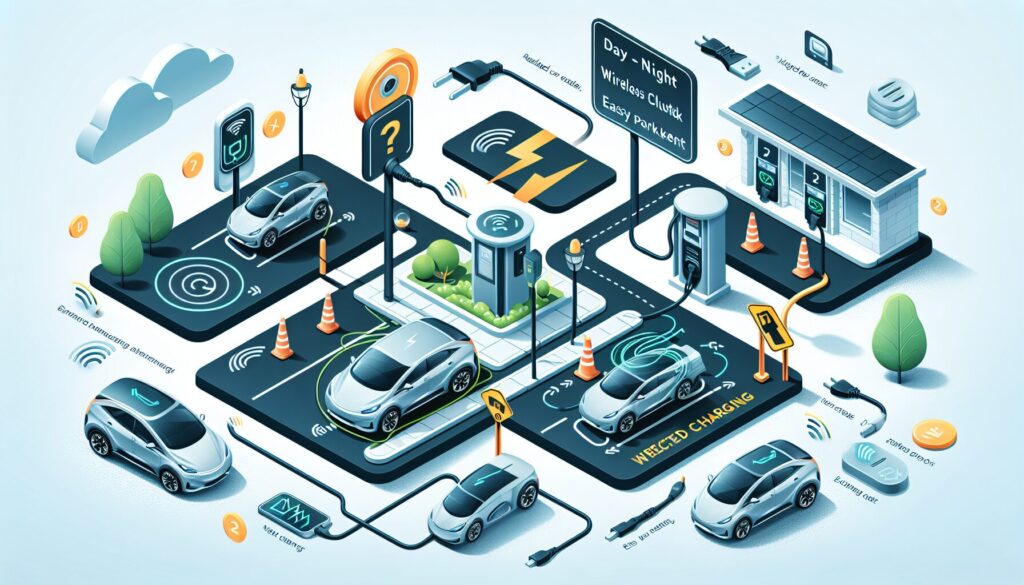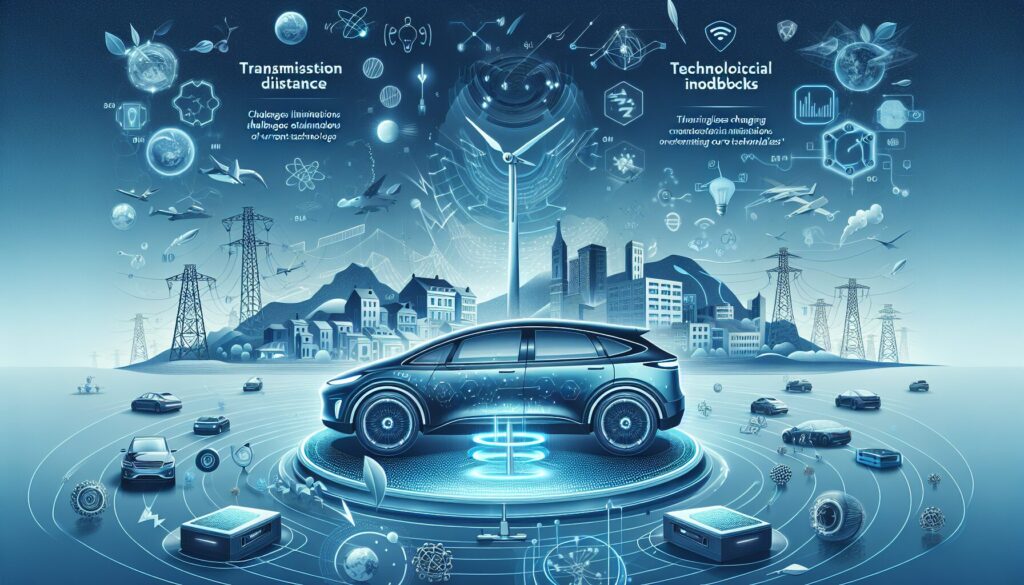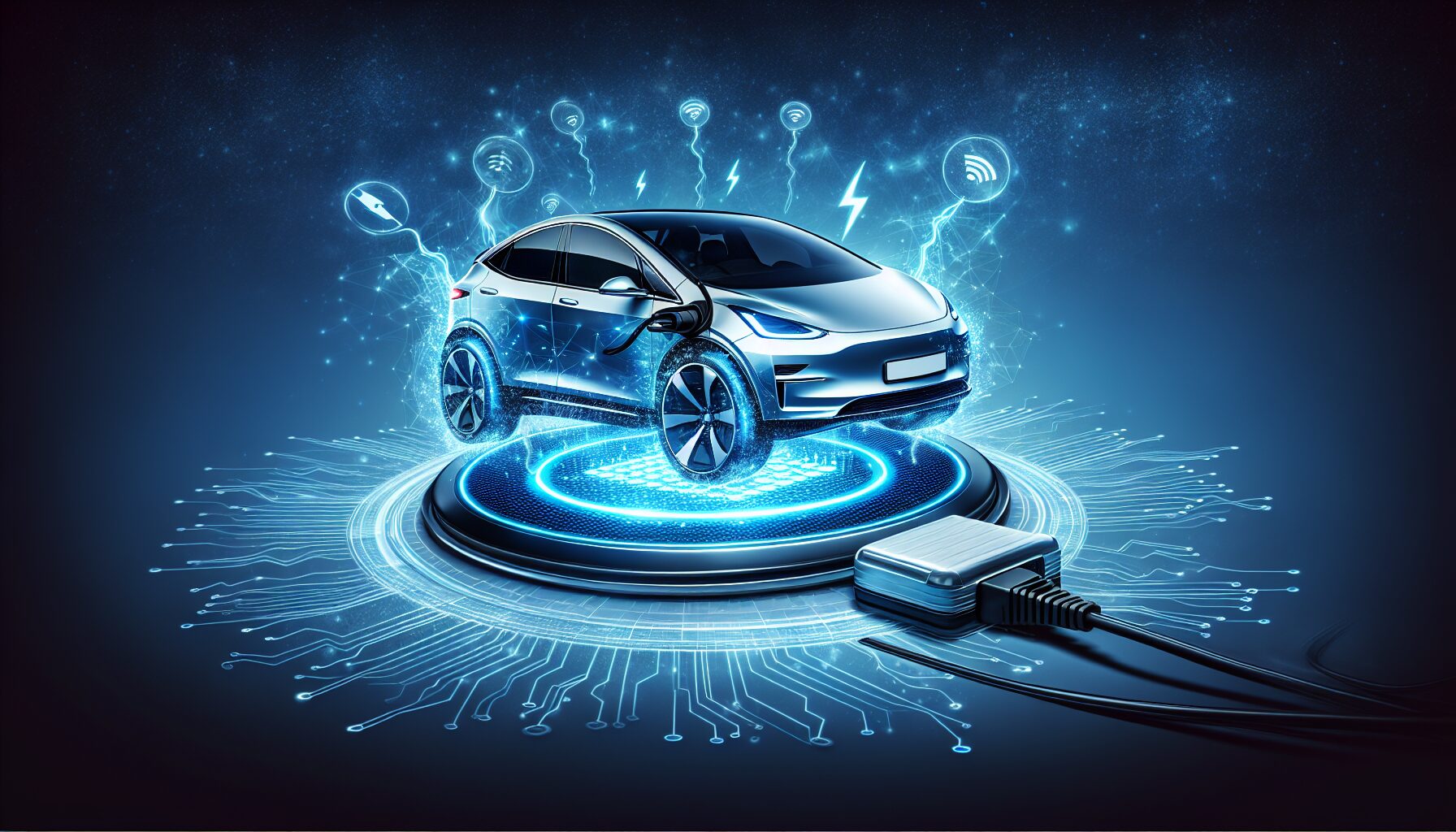Imagine cruising through the stunning landscapes of Canada without ever worrying about plugging in your electric vehicle. That’s the magic of wireless charging technology! It’s like having a phone charger embedded in the road. At the heart of this innovation is resonant inductive coupling, a method that transfers energy between coils using electromagnetic fields. This tech is boosted by GaN-based power amplifiers, which make the process more efficient. Plus, the SAE J2954 standard ensures compatibility across vehicles. I remember reading about this in an engineering magazine during a snowy day in Toronto, and it felt like the future was already here! Companies like `Plugless Power` and `WiTricity` are leading the charge. This technology is transforming how we think about powering our EVs, making road trips even more exciting and eco-friendly. Now, let’s dive deeper into how it all works!
Related: The Ultimate Guide to Wireless charging technology for electric cars
How Wireless Charging Works for EVs
Imagine pulling into your garage after a long day and not having to fumble with cables to charge your electric vehicle. Instead, you just park, and voila, the charging starts automatically! That’s the magic of wireless charging for electric vehicles. At its core, this technology relies on resonant inductive coupling. It’s a bit like how you might charge your smartphone wirelessly, but on a larger scale. This involves creating an electromagnetic field between two coils: one installed on the ground and the other in your vehicle.
Now, what makes this tech truly fascinating is the use of GaN-based power semiconductors. These little wonders allow for efficient power conversion, minimizing losses and maximizing energy transfer. The science behind it is quite impressive and ensures that the energy transfer is as efficient as plugging in. Plus, there’s the SAE J2954 standard, which ensures compatibility and safety across different brands and models of electric vehicles.
The Wireless Charging Process
So, how does it all come together? When you park your EV over a charging pad, the primary coil in the pad creates an alternating magnetic field. The secondary coil in the vehicle picks up this energy and converts it back into electricity to charge the battery. It’s seamless and incredibly convenient. But that’s not all! With advancements in technology, companies are working towards making this process even faster and more efficient. Major players like `WiTricity` and `Qualcomm` are at the forefront of these innovations.
In Canada, where winters can be harsh and the idea of stepping out to plug in your car can be daunting, this innovation is a game changer. Imagine never having to deal with icy cables or worrying about plugging in during a snowstorm. Instead, just drive into your garage and let the magic happen. It’s exciting to think about how this technology will evolve and become a staple in our daily lives, making owning an electric vehicle more appealing than ever.
Benefits of Wireless Charging for Electric Vehicles

Imagine pulling into your garage on a chilly Canadian evening and simply parking your car, letting it charge wirelessly. No fumbling with cords in the cold! The magic behind this convenience is resonant inductive coupling, which allows energy to transfer between two coils—one in the ground and one in your car. This process is enhanced by GaN (Gallium Nitride) semiconductors, which improve efficiency and reduce energy loss. How cool is that?
Wireless charging isn’t just about convenience, though. It’s also about safety and durability. Without cords and plugs, there’s less wear and tear, reducing maintenance costs over time. You won’t have to worry about tripping over tangled cables in your garage. Additionally, the SAE J2954 standard ensures compatibility and safety across different manufacturers. This means you can trust the technology to work seamlessly with your vehicle.
Environmental and Economic Benefits
Moreover, wireless charging can contribute to a cleaner environment. By making EV charging easier, more people might be encouraged to switch from traditional gas vehicles. This shift can significantly reduce greenhouse gas emissions. A study from IEEE suggests that widespread adoption could lead to a substantial decrease in urban pollution.
On the economic side, businesses and municipalities could benefit, too. For instance, parking lots equipped with wireless charging pads can attract more EV drivers, boosting local commerce. Municipalities might also see a reduction in urban infrastructure costs by decreasing the need for complex charging stations. Therefore, the advantages of wireless charging for electric vehicles are not just personal; they ripple across communities and economies, making it a win-win for everyone.
Challenges and Limitations of Current Technologies

Ever tried to park your electric vehicle over a wireless charging pad and found it a bit like trying to align a spaceship? I remember my first attempt with my EV, and it was quite the adventure! Let’s dive into why it’s not always smooth sailing. Wireless charging for electric cars, or Inductive Power Transfer (IPT), relies on creating a magnetic field between coils. However, positioning is crucial. If your vehicle isn’t perfectly aligned, efficiency drops significantly. It’s kind of like trying to charge your phone on a wireless pad that’s a bit off-center; it just doesn’t work well.
Another challenge is the power transfer efficiency. Current tech often uses GaN-based power electronics to boost performance, but we’re still not at the level we want. I’ve read that energy loss can be as high as 20%. That’s not great when you’re trying to be eco-friendly and save some bucks on your electricity bill. Plus, the magnetic resonance coupling technology, while promising, is still evolving. Many of us are eager for improvements in this area.
Infrastructure and Cost Issues
The infrastructure needed for widespread adoption is also a hurdle. Imagine needing to retrofit thousands of parking spots across Canada! The cost can be prohibitive. Organizations like `Electric Mobility Canada` are pushing for advancements, but it’s a slow process. Additionally, installation of these systems can be complex and costly, especially in urban areas where space is limited.
Finally, there are concerns about standardization. Different manufacturers have varying implementations, making cross-compatibility an issue. The ultimate guide to wireless charging technology for electric cars dives deeper into these technicalities. Until we have a universally accepted standard, this will remain a sticking point. As tech evolves, I’m hopeful we’ll overcome these challenges sooner rather than later.
Future Trends in Wireless Charging for EVs
Imagine a future where electric vehicles (EVs) glide into your garage and automatically start charging without any plugs. It’s not just a dream! We’re talking about resonant inductive coupling, which is the magic behind wireless power transfer. With advancements in GaN-based power electronics, the efficiency and range of these systems are rapidly improving. This technology is not just a buzzword, but actively shaping the future of EVs. A few months ago, I attended a tech expo in Vancouver, and the buzz around this tech was palpable. Industry leaders like `SAE International` are hard at work, refining standards like SAE J2954 to ensure seamless interoperability between vehicles and charging stations.
Excitingly, many Canadian cities are exploring these innovations to redefine urban mobility. Toronto, for example, is piloting projects that integrate wireless charging pads into parking spaces. This could revolutionize the way urban residents power their vehicles. Moreover, public transit systems are also eyeing wireless charging to keep electric buses running smoothly. Imagine the convenience and environmental benefits!
What’s Next for Canada?
With the Canadian government’s commitment to reducing carbon emissions, the push for electrifying transportation is stronger than ever. As wireless charging tech becomes more mainstream, we could see it in more public spaces. The involvement of organizations like `Natural Resources Canada` is crucial, ensuring the infrastructure keeps pace with technological advancements. With continued research and investment, the dream of a plug-free future is closer than we think. We might even see highways equipped with embedded charging systems in the not-so-distant future. After all, who wouldn’t want to charge their EV while cruising down the road? The possibilities are endless, and it’s an exciting time for Canadian EV enthusiasts!
Conclusion
To sum up, wireless charging technology is revolutionizing the electric vehicle landscape by offering unparalleled convenience, safety, and environmental benefits. Despite current challenges in efficiency and infrastructure, the ongoing advancements in GaN-based electronics and standardization efforts promise a future where EV charging is seamless and widespread. As Canada embraces this transformative technology, the vision of a plug-free, eco-friendly driving experience is becoming a reality. Here’s to a future of effortless and sustainable journeys!
Continue Exploring
Curious about the future of energy in Pakistan? Dive into the groundbreaking world of solid-state batteries and uncover the latest laws shaping this innovative technology.
Frequently Asked Questions
How does wireless charging technology work for electric vehicles?
Wireless charging for electric vehicles operates using a process called electromagnetic induction. This involves transferring energy between two coils: one embedded in the ground at the charging station and the other installed in the vehicle. When the vehicle is parked over the ground coil, an alternating current passes through it, creating a magnetic field. This field induces a current in the vehicle’s coil, charging the battery without any physical connection.
What are the benefits of using wireless charging systems for EV owners?
Wireless charging systems offer several advantages for EV owners, including increased convenience, as there is no need to plug in cables manually. This technology also enhances safety by reducing wear and tear on physical connectors and eliminating tripping hazards. Moreover, it can lead to greater adoption of electric vehicles by simplifying the charging process, making it as easy as parking the car.
Are there any drawbacks or limitations to wireless charging for electric vehicles?
While wireless charging offers numerous benefits, it does have some limitations. The efficiency of wireless charging is generally lower compared to traditional plug-in methods, potentially leading to longer charging times. Additionally, the cost of installing wireless charging infrastructure can be higher, and compatibility among different vehicle models may vary. Current technology typically requires precise alignment between the vehicle and charging pad for optimal performance, though ongoing advancements are addressing these challenges.


Leave a Reply